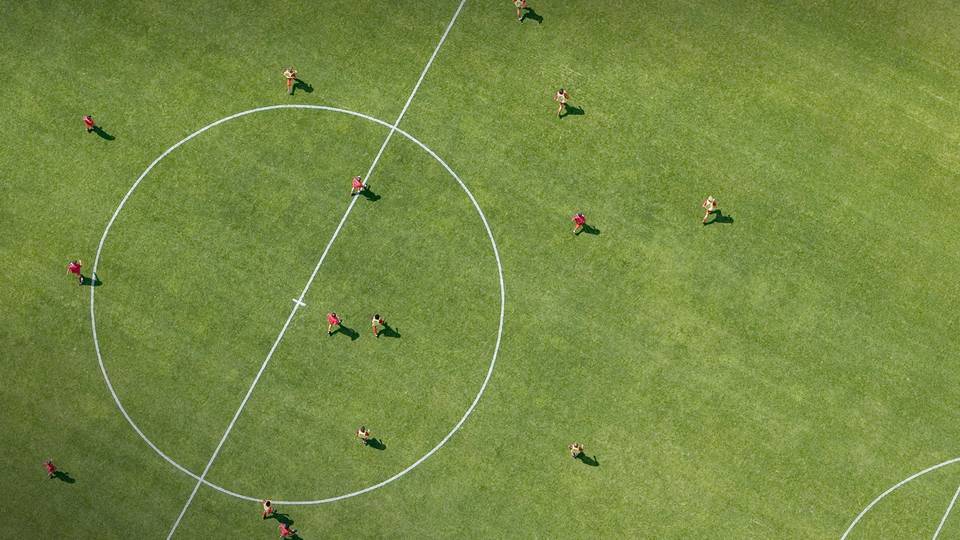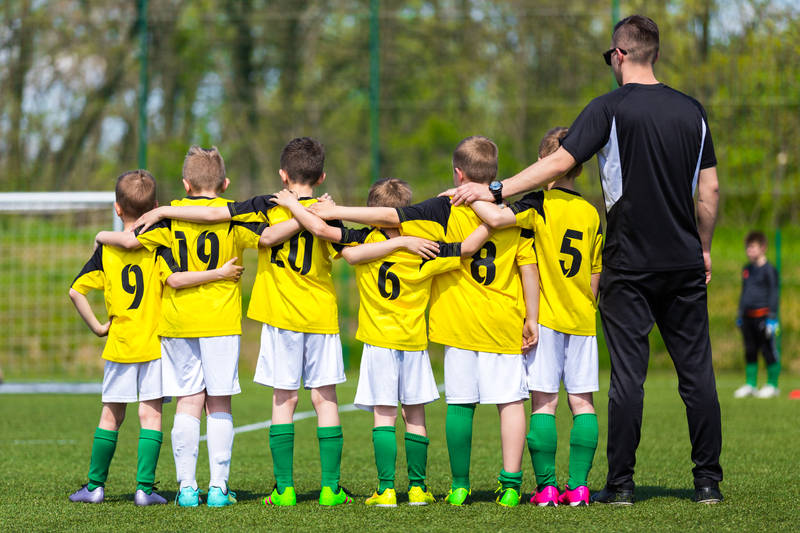Transitioning from small-sided games to full pitch matches requires young footballers to develop specific tactical awareness and technical skills. 9-a-side football serves as the perfect bridge, combining elements of small group play with more complex positional responsibilities. Effective 9v9 drills focus on creating numerical advantages, improving decision-making, and enhancing players' ability to recognise and exploit space across the wider playing area.
Well-structured 9v9 practice sessions should incorporate playing out from the back, creating 2v1 situations, and developing attacking patterns that translate to match scenarios. These drills help players understand their roles within formations while building confidence in possession. Many coaches find that organising exercises where players must scan the pitch and make quick decisions significantly improves match performance.
The best training approaches combine technical elements with tactical understanding, preparing young players for the eventual move to 11-a-side football. By focusing on specific scenarios like attacking transitions or defensive shape, coaches can help their teams develop a coherent style of play that maximises individual strengths. Regular practice in these scenarios creates muscle memory and tactical intelligence that becomes invaluable during competitive matches.
Essential 9v9 Football Drills
Training sessions for 9-a-side football require specific drills that address tactical understanding, proper formations, and specialised goalkeeper skills. These elements work together to create a cohesive team approach that maximises performance on a smaller pitch.
Developing Tactical Understanding
Building tactical awareness in 9v9 formations begins with pattern-of-play exercises. A fundamental drill involves playing out from the back, where one player passes to another and follows their pass, creating movement patterns throughout the team.
Set up a possession-based exercise in a 30x20m grid with two teams of 4 players plus a neutral player. Focus on maintaining possession while achieving a specific target (such as 5 consecutive passes before switching play).
Small-sided games (5v4 or 6v3) help players understand pressing triggers, defensive shape, and when to exploit space. These games should include clear objectives:
- Create attacking overloads
- Switch play from congested areas
- Recognise when to press as a unit
Progressive Build-up Drill: Start with a 3v1 scenario in one zone, advancing to 5v3 in the middle zone, and finishing with 7v5 in the final third.
Improving Team Formations and Positioning
The most effective 9v9 formations typically include 3-2-3, 3-3-2, or 3-4-1 setups. Position-specific drills help players understand their roles within these structures.
Create channel games where players must stay in designated zones initially, then gradually remove restrictions. This develops positional discipline while teaching players how to create width and depth.
Shadow play exercises without opposition allow teams to practise movement patterns. The coach freezes play at key moments to highlight proper positioning and potential adjustments.
Transition Focus: Implement quick transition drills where players must rapidly shift from attack to defence and vice versa. Start with a goalkeeper distribution to defenders who build play forward through midfield.
For midfielders, rotational exercises emphasise their dual defensive and attacking responsibilities. Defenders should practise maintaining their shape while covering for teammates who move forward.
Enhancing Goalkeeper Skills
Goalkeeper training for 9v9 matches should balance traditional shot-stopping with distribution skills. Keepers need to be comfortable with the ball at their feet and make quick decisions under pressure.
Distribution drills should include:
- Short passes to fullbacks
- Medium-range passes to midfielders
- Long distribution to wingers or forwards
Practice scenarios where the goalkeeper receives back passes under pressure. Set up a small-sided game (4v4) with the goalkeeper acting as an additional outfield player for the team in possession.
Creates drills that force decision-making, such as having two attacking players approach while the keeper must decide whether to stay on their line or come forward. Implement handling exercises specific to youth-sized goals, focusing on high balls and crosses.
Communication drills help goalkeepers organise their defence during set pieces and open play. They should practice vocal commands that direct defensive teammates appropriately during matches.
Skill Building for Midfield Dominance
Midfield control determines the flow and tempo of a 9v9 match, requiring players to master both technical skills and tactical awareness. Developing strong passing abilities and spatial recognition enables midfielders to maintain possession and create attacking opportunities.
Passing and Possession Drills
The rondo drill stands out as an essential practice activity for midfielders. Set up a 5v2 or 6v2 exercise in a 10-yard square where players must maintain possession with one-touch or two-touch passing. This develops quick decision-making and accurate ball distribution.
Triangle passing drills enhance midfield fluency. Position three players in a triangle formation approximately 8-10 yards apart, with one midfielder moving to receive and distribute the ball to teammates. Add defensive pressure gradually to increase difficulty.
The midfield box possession game (4v4+3) utilises neutral players who always support the team in possession. This creates numerical advantages similar to match situations and teaches midfielders to find and use space effectively.
For advanced teams, implement the "third man run" drill where players must pass, move and create passing angles that mimic real match scenarios.
Agility and Midfield Play Exercises
Midfielders require exceptional agility to navigate tight spaces. Set up a cone slalom course with balls positioned at various points. Players must dribble through cones, perform quick direction changes, and execute passes to targets at the end of each run.
The midfield transition game develops both attacking and defensive awareness. Divide your area into three zones with 3v2 in each end zone and 2v2 in the middle. The objective is to move the ball from one end to the other through the middle zone, requiring quick shifts between defence and attack.
Shuttle runs with ball skills enhance speed and coordination. Set up two lines of cones 15 yards apart with players performing sprints between lines, incorporating technical elements like receiving on the half-turn or playing one-touch passes on arrival.
The mirror drill improves defensive positioning. Pair players facing each other, with one acting as the attacker making unpredictable movements while the defender must shadow them precisely, maintaining proper distance and body orientation.
Attacking and Defending Strategies
Successful 9-a-side football requires balanced tactical approaches on both sides of the ball. Effective teams develop patterns of play that allow them to control the game through structured movements and positioning.
Perfecting Attacking Movements
When developing attacking strategies, focus on creating and exploiting space. Players should understand triangular movements that provide passing options and width.
Train forwards to make diverse runs - checking toward the ball, running behind defenders, and moving into channels. These varied movements confuse defenders and create openings.
Establish clear transition patterns from defence to attack. The 3-2-3 formation works effectively for many youth teams, providing balance between defensive security and attacking threat.
Implement quick combination play drills where players execute one-touch or two-touch sequences in tight spaces. This improves decision-making and technical execution under pressure.
Practice third-man running patterns where the receiver immediately looks for supporting runners after receiving the ball. This creates dynamic attacking flow.
Organising the Defending Team
Defending in 9-a-side requires excellent communication and shape. Establish clear defensive principles including pressing triggers, recovery positions and compactness.
Train your back line to maintain appropriate distances between defenders - too wide creates gaps, too narrow limits coverage. Approximately 3-4 metres between players often works well.
Develop recovery runs as a priority defensive skill. Players must understand how to track runners while simultaneously watching the ball.
Implement shadow defending drills where players move as a unit without opposition, then progress to controlled opposition. This builds muscle memory for proper positioning.
Teach the concept of defensive cover where the closest player pressures the ball while others provide support behind. This layered defence reduces opponent penetration.
Work on defensive transitions with immediate counter-pressing when possession is lost. The first 5-6 seconds after losing the ball are critical for regaining control.
Executing Drills for Playing Out from the Back
Building attacks from defensive positions requires confidence and technical skills. Develop progressive practices that increase pressure gradually as players master each stage.
Start with unopposed passing patterns where defenders receive from the goalkeeper and play to midfielders. Establish clear passing lanes and communication signals.
Introduce "rondo" drills in relevant shapes to your formation. For example, use 4v2 or 5v2 boxes where defenders must maintain possession under pressure from opponents.
Create game-realistic scenarios with partial pressure. Begin with one pressing attacker, then gradually add more as players become comfortable playing through pressure.
Practice split-line passes that break defensive lines. Defenders should recognise when to play safe (sideways/backwards) versus when to progress play forward.
Teach goalkeepers to function as the first attacker, using varied distribution including short passes, driven balls to wide areas, and appropriate long kicks when needed.
Equipment and Gear for Effective Training
Proper training equipment is essential for developing skills in 9v9 football. The right gear not only enhances player performance but also creates a safe and effective learning environment.
Selecting Appropriate Soccer Balls
Quality footballs form the foundation of any training session. Size 4 balls are ideal for 9v9 youth teams (typically U11-U12), while older players use size 5 regulation balls.
Training balls should be durable with good air retention capabilities for consistent performance on various surfaces. Look for balls with water-resistant coatings for wet weather training sessions.
Match balls offer better flight characteristics and touch sensitivity but reserve these for match days or specific technical drills due to their higher cost. Consider having multiple ball types:
- Training balls: Durable and cost-effective for daily drills
- Futsal balls: Lower bounce for indoor technical work
- Indoor balls: Specially designed for hard surfaces with reduced rebound
- All-weather balls: Essential for year-round training in British conditions
Choosing Goalkeeper and Player Gear
Goalkeeper training demands specialised equipment to develop handling, positioning and reaction skills. Quality goalkeeper gloves with appropriate finger protection are essential for safety and confidence.
For outfield players, training bibs (pinnies) in multiple colours help organise teams during practice games and tactical work. These should be lightweight, breathable and easily distinguishable.
Training-specific clothing differs from match uniforms. Players need:
- Breathable training jerseys
- Comfortable shorts with sufficient movement range
- Proper football socks that hold shin guards securely
- Weather-appropriate base layers for cold conditions
Custom training kits create team identity but aren't essential. Focus instead on functionality and comfort for frequent use.
Utilizing Ground and Gameday Equipment
Portable goals in various sizes support targeted training activities. Small pop-up goals work brilliantly for finishing exercises and possession games, while regulation 9v9 goals are needed for match-simulation training.
Essential ground equipment includes:
- Agility ladders: For footwork and coordination drills
- Training hurdles: To develop jumping technique and agility
- Marker cones: For defining training areas and obstacle courses
- Rebounders: To improve passing accuracy and first touch
- Coaching boards: For tactical instruction and positioning work
Space-dividing equipment like portable nets allows multiple groups to train simultaneously without ball interference. Resistance bands provide strength training options within football-specific movements.
Equipment should be stored properly to extend its lifespan. Invest in durable carry bags for transportable items and establish a system for quick setup and breakdown of training stations.












